Three Artists, Three Visions
Posted on Thu., May 21, 2015 by
African-American Art at The Huntington
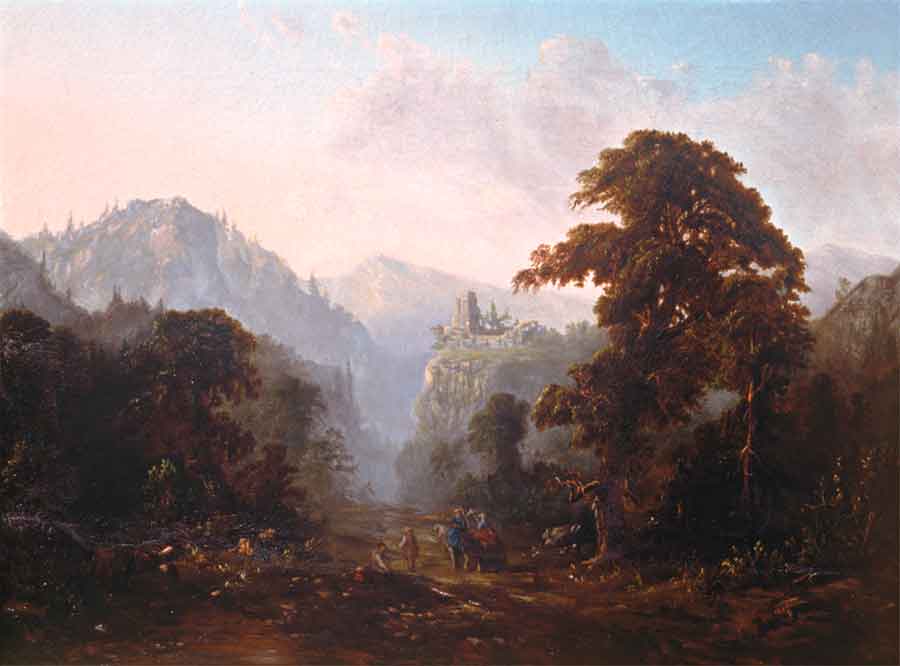
Although he had no formal fine art training, Robert S. Duncanson became the first African-American artist with an international reputation. His Landscape with Ruin, ca. 1853, likely dates to the period after his return from Italy to Cincinnati, Ohio, where he had launched his career as an artist.
The Huntington continues to fill in gaps in its collecting areas, most recently by homing in on works by African-American artists. Since the Art Collectors' Council acquired an organ screen by Sargent Claude Johnson in 2011, the collection of African-American art has continued to grow through gifts and purchases. Bram and Sandra Dijkstra donated Charles White's Soldier (1944) and Robert S. Duncanson's Landscape with Ruin (ca. 1853); a brilliant red-orange ceramic mural by Doyle Lane went on public display in the recently opened Steven S. Koblik Education and Visitor Center; and to celebrate the opening of an addition to the Lois and Robert F. Erburu Gallery, Faye and Robert Davidson loaned a powerful Charles White painting, Preacher (1940), as well as an exquisite hammered copper mask by Johnson. These artists demonstrate widely different approaches to making art—from Duncanson's oil paintings of European-inspired landscapes to Charles White's pained, expressive figures to Doyle Lane's luminously glazed ceramic tiles.
Robert S. Duncanson (1821–1872)
Duncanson was from a family of what were then called "free colored people." The family settled in the Finger Lakes region of New York sometime after 1790. His grandfather was born a slave in Virginia but was freed and eventually traveled north. Duncanson, who came from a family of skilled craftsmen, opened a house-painting business in Munroe, Mich., and then moved to Cincinnati, the "Athens of the West," as it was called, to seek better opportunities. With a community of black freedmen and abolitionists, not to mention a vibrant cultural life with art galleries and schools, Cincinnati offered him resources to launch his career as an artist. And so, although he had no formal fine art training, he became the first African-American artist to gain an international reputation. He visited Europe at least four times and exhibited in Montreal, Dublin, and London. While in Montreal during the early years of the Civil War, he was represented by a gallery and is thought to have influenced Canadian landscape painters with his meticulously rendered depictions of the Quebec countryside. And, he was lavishly praised in the British press.
Throughout his career, Duncanson took up subjects from poetry and literature—in particular, the novels of Sir Walter Scott. However, The Huntington's Duncanson painting, bathed in rosy crepuscular light, is a moody imagined landscape that does not appear to derive from any specific literary source. With its ruined castle balanced on a sheer cliff, it is an American's dream of Europe taken from Gothic novels and epic poems. Perhaps the foreground figures immersed in shadows relate to his experience of crossing the Alps on his way from France to Italy. The picture likely dates to the period after Duncanson's return from Italy to Cincinnati. Rather than referring to a Hudson River School artist like John Frederick Kensett, whose Rocky Landscape (1853) hangs at The Huntington, Duncanson's dark picture looks to Salvator Rosa, an Italian landscape painter. This indicates Duncanson's wish to demonstrate his cosmopolitan sophistication.
Charles White (1918–1979)
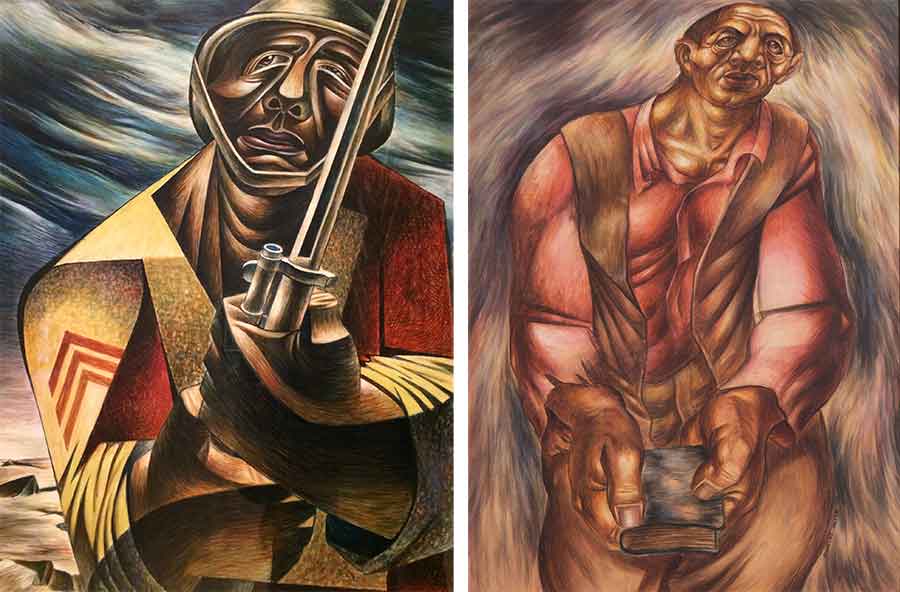
Charles White addressed the terrible history of racial inequality in the United States through portraiture, painting historical figures and generalized types, such as his Soldier, 1944 (left), and Preacher, 1940 (right).
Created by an artist committed to using his talent to address racism and bring about social change, Charles White's Soldier depicts a black Army sergeant holding a gun with expressive and powerful hands. Growing up on Chicago's South Side, where African Americans from the South had journeyed during the Great Migration, White took an early interest in art and won not one but two art scholarships. However, in both cases, when he and his mother went to collect his prize and register for courses, the award committees falsely claimed to have made a mistake once they realized his race. Undaunted, he enrolled at the Art Institute of Chicago on a third scholarship and finished his two years of coursework in only one. Fresh out of art school, he painted the mural Five Great American Negroes for the Federal Art Project in Illinois, exhibited his work at the Library of Congress, and was commissioned to do another mural on the history of African-American publishing. Shortly after enlisting in the Army during World War II, he contracted tuberculosis, then nearly incurable, and was discharged. During his long convalescence, he stopped painting but read extensively. Soldier likely comes from after this period and may reflect on the cruel paradox that black soldiers, while fighting racist and fascist regimes abroad, were subjected to racism at home and in the U.S. Armed Forces, which remained segregated until 1948.
Across many decades, White addressed the terrible history of racial inequality in the United States through portraiture, painting historical figures—such as Abraham Lincoln, Harriet Tubman, and Booker T. Washington—and generalized types, such as Soldier and Preacher. These "types" fight the hateful stereotypes that once filled Hollywood films, comic strips, and even cartoon movies. Both Soldier and Preacher present black men gazing heavenward, as if lost in thought or prayer. By putting their interiority on display, White forces the viewer to empathize with these men and shows our common humanity while acknowledging race.
Doyle Lane (1925–2002)
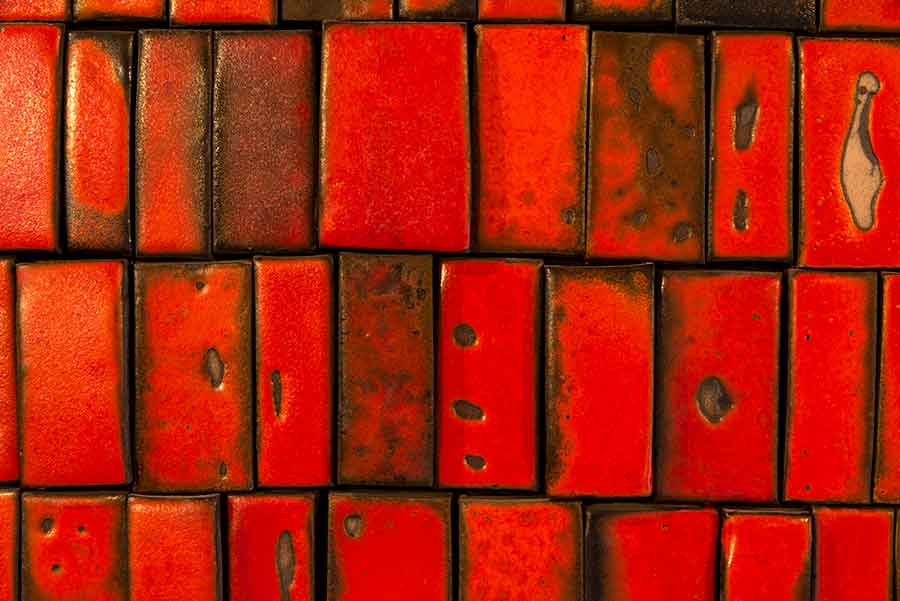
Doyle Lane transformed his ceramic works into what he called "clay paintings," as seen in his Mutual Savings and Loan Mural, 1964. Photographs by Joshua White.
Active as a ceramic artist in Los Angeles, Doyle Lane started out making traditional functional objects—such as cups, bowls, pots, and vases—thrown on a wheel and fired in a kiln. However, like other ceramists in Southern California—such as Peter Voulkos, who took a cue from abstract sculpture and created shattered and fractured forms—Lane resisted the association of ceramics with functionality by transforming his work into what he called "clay paintings." Lane employed various colored glazes and glaze techniques to achieve textures that ranged from blistered to icy smooth. The Huntington's Lane mural was commissioned by the 1960s architectural firm Welton Becket and Associates for the Pasadena branch of Mutual Savings and Loan. Lane took the mural's size (17 feet long and more than 8 feet high) and public location as an opportunity to make a statement. First, grids and patterns found in Lane's mural were widely incorporated into paintings during the 1960s by artists as diverse as Frederick Hammersley and Robert Rauschenberg. Second, while from a distance the mural has a pleasing regularity and seems to be a bright red-orange, on closer inspection, you notice that Lane injected an element of irregularity. A master of notoriously finicky red glazes, he worked with rather than against their unpredictable nature—the tiles' color shifts from red to orange with areas of green and black in between. Moreover, patches of unglazed brown clay peek through in some places, and bubbles from gases formed during firing vary the tiles' surfaces. Finally, the tiles are placed at various levels, making them not like bathroom and kitchen tiles that flatly cling to a wall but like loosely stacked blocks. Lane turned each small tile into an abstract painting that seems to radiate light and then stacked them into a wobbly, almost-animated wall. The mural reveals an artist pushing the ceramic medium to new levels of complexity and using an architectural commission to realize his own vision.
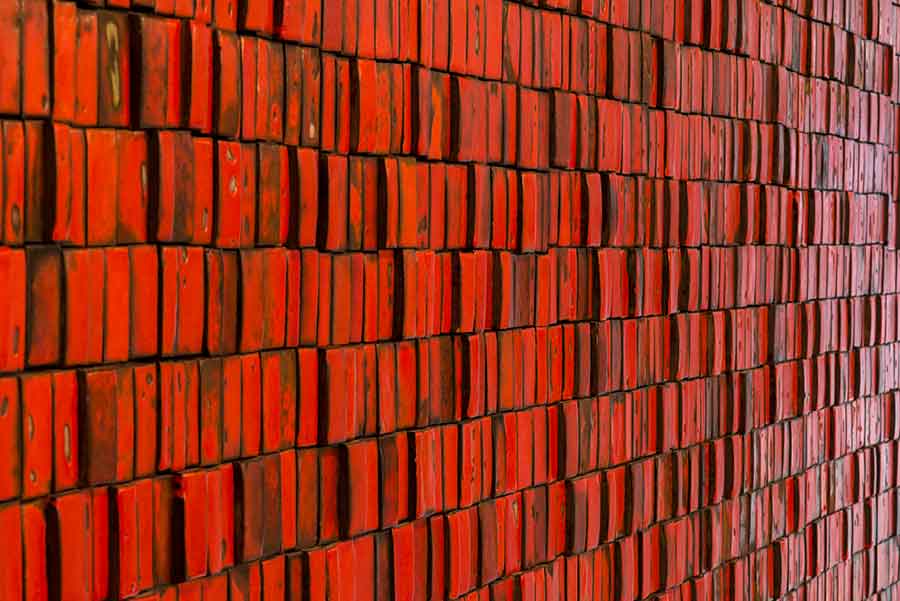
Doyle Lane transformed his ceramic works into what he called "clay paintings," as seen in his Mutual Savings and Loan Mural, 1964. Photographs by Joshua White.
Unlike Charles White's portraits, Lane's work does not overtly engage in questions of race and civil rights. However, he did address racial prejudice in a thoughtful interview conducted for Studio Potter in the early 1980s. When the interviewer asked Lane about his relative lack of success compared to Peter Voulkos or Ken Price, who were widely renowned sculptors at the time, Lane said, "It was definitely a fact then [in the 1950s and 1960s] that the galleries weren't accepting and giving black artists a chance or the breaks they needed." (Indeed, beyond the Brockman Gallery and a handful of other black-owned galleries, there were few spaces in Los Angeles where black artists were invited to exhibit their work, although LACMA mounted the occasional show.) Lane was pessimistic about the future. He cited a recent exhibition of early California potters that did not include a single black artist as more evidence that museums "seem to be continuing the same trend, not necessarily discriminating but just ignoring black artists." In light of Lane's comments, the installation of his mural at The Huntington, where thousands of visitors are able to see and enjoy his artistry, takes on extra poignancy. Its public display helps spread the word about his tremendous technical skills and experiments in transforming the ceramic medium into something that is not quite painting and not quite sculpture, but something unique to Doyle Lane.
Restoring Tiles
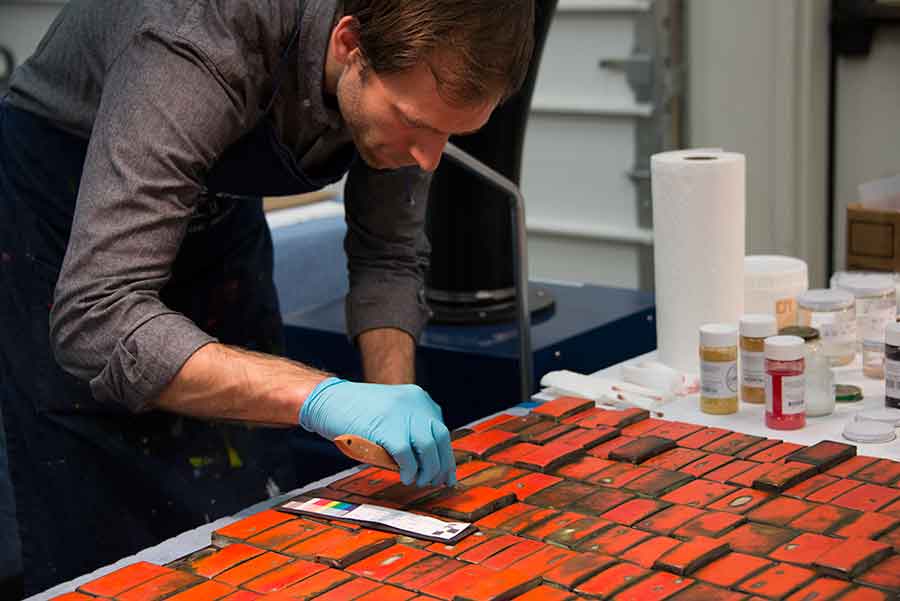
Sculptor and freelance conservator Morgan MacLean spent four months at The Huntington—documenting, treating, and installing the Lane mural in the new Steven S. Koblik Education and Visitor Center. In this photograph, MacLean uses an artist knife to apply a thin coat of a treatment comprising acetone, Paraloid B-72 (a clear acrylic resin), marble powder, and dry pigment to a damaged section of a tile. Out of the 4,876 tiles that make up the mural, MacLean restored 256 tiles that showed some evidence of damage.
James Glisson is the Bradford and Christine Mishler Assistant Curator of American Art at The Huntington